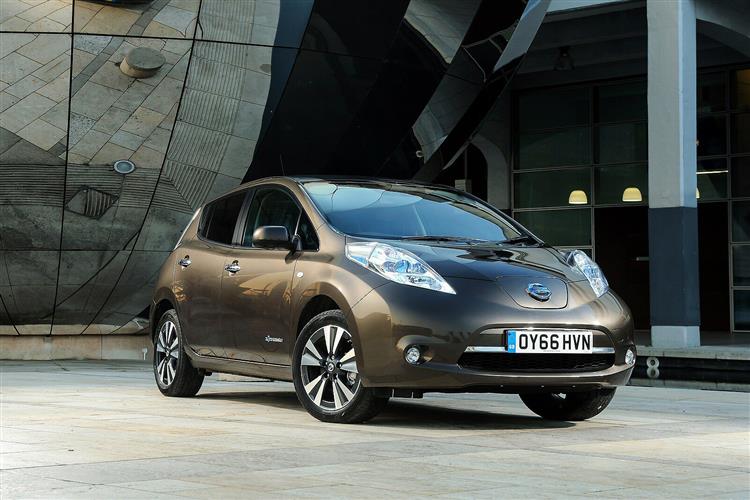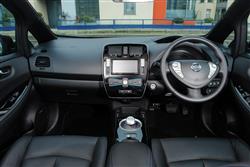This is a sample, showing 30 seconds of each section.
LEAF GLOWING (some text hidden) SECTIONED_new_nissanleaf_2014
By Jonathan Crouch
Introductionword count: 147
Plugging our cars into the mains electricity supply when we get home at night might still might seem about as natural as shovelling coal into them before setting off in the morning, but all the signs are that's going to change. Hybrid cars were a first step in the direction of increased use of electricity to drive our vehicles and fully electric models will be the next. Owning a car that will never go near a filling station forecourt except to use the jet wash or inflate its tyres might take some getting used to but Nissan has long been confident that its LEAF all-electric family hatch can make the transition a painless one. In 2013, the brand upgraded the first generation version of this design with an increased range and quicker charging time. This is the version we check out here as a potential used buy.
Modelsword count: 7
5dr family hatchback (EV [Visia, Acenta, Tekna])
Historyword count: 276
The 'LEAF' name is an acronym for 'Leading Environmentally friendly Affordable Family car' - which is exactly what this was when first we saw it launched in 2011 as the first purpose-designed pure electric vehicle on the market. Back then, the only other offering in this segment was hastily converted citycar design sold under different badges by Mitsubishi, Peugeot and Citroen. In comparison, the prospect of spending similar money on a larger, more advanced Nissan LEAF seemed like a no-brainer decision for anyone seriously considering a car of this sort. The problem for Nissan, in the UK at least, was that in the early years of the 21st century's second decade, hardly anyone was considering buying a full-electric family vehicle. And certainly not one costing close to £30,000. A LEAF might have been better than anything else on offer in this era but it was still beset by the usual EV issues of low operating range and patchy public charging infrastructure. It was, in short, a car ahead of its time. By 2013 though, there were signs that things might be changing and that the public might be warming to this model. By this time, the cost of electric technology had come down and the number of public charging points had dramatically increased. Plus the whole idea of owning a pure electric car had been more widely accepted. It was a change in mindset Nissan aimed to capitalise on by re-launching the LEAF with a smarter, more practical interior and a longer operating range. This model sold until an all-new second generation LEAF which a much longer operating range was introduced at the end of 2017.
What You Getword count: 1061
The LEAF was the first mass production electric vehicle to be designed from the ground up for purely battery power. Early EVs were merely conversions of cars originally created with petrol engines. Even if you didn't know this, you could perhaps guess the fact from a glance at this dramatic-looking Nissan. For example, since, as an all-electric car, there was no need to fit a bulky engine in the front, it has a stubby and sharply-angled nose that produces a smart wedge profile and aids the strong aerodynamic performance. With this revised post-'13-era model - British-built in Sunderland - that nose also had to also accommodate the bulky charger and inverter which previously took up space in the boot, but the designers managed to sort that without affecting the bonnet line. So, as with the original version of this MK1 model, the so-called 'smart fluidity' looks remain a little unorthodox - subtle grille changes are the only visual update over the 2011-era model. That and the addition of an LED light under the charger lid which makes it a bit easier to connect up at night. Otherwise, nothing's really very different and the futuristic styling remained unaltered - but then many will feel that to be wholly appropriate for such a groundbreaking car. The quirkiest detail is probably the raised profile of the blue LED headlamps, positioned to channel air away from the wing mirrors and reduce road noise. Things get a little more bulbous around a rear end dominated by a kicked-up roofline and gently curved vertical tail lights - and of course notable for the total absence of an exhaust pipe. There is of course a battery instead, as before a 48-module lithium-ion powerpack that isn't housed in the boot but under the vehicle's floor, helping create the low centre of gravity that helps so much with the handling. But the perhaps the most important thing is the overall size. At around 4.5m long, this was the first pure electric car big enough for proper family use, no more than around 200kgs heavier than a similarly shaped conventional model and offering cabin space and overall dimensions very comparable to that of a conventional Ford Focus-style family hatchback. Back in 2013, no other EV on the market could offer you more rear seat space. Thanks to redesigned front seats that freed up another 53mm of legroom for rearward folk, the bench in the back of this post-'13-era model can comfortably accommodate three adults on short journeys, two on longer ones and a trio of kids all day long. The important practical news with this revised MK1 model LEAF though, lies further back. We mentioned earlier that the charger and the inverter the battery pack needs were moved forward from the boot to the bonnet in this revised MK1 model. Well that made a big difference to the cargo area. Luggage space in this post-'13-era design is rated at 330-litres, a 40-litre increase over the original car - about the size of a piece of airline carry-on baggage (though top models lose 15-litres of that thanks to the need to house the sub-woofer of the punchy Bose stereo). More importantly, when you push the 60/40 split-folding rear bench forward (something you can't do in a rival Renault Fluence ZE all-electric hatch model from this era), you get a completely flat loading floor. True, the total cargo room on offer isn't especially big: the 1,100-litre total potential seats-folded luggage area that you'd expect when travelling two-up in a conventional family hatch is reduced here to just 680-litres. But we can't see that unduly bothering too many potential buyers. The reason the boot isn't bigger is that the lithium-ion battery pack is mounted beneath the floor of the vehicle, a more pleasing consequence of which is the slightly raised driving position you get behind the wheel. On this improved MK1 LEAF model, there's also the bonus that you can further adjust your seat for height should you want to. Unfortunately, the more pressing change needed in this cabin - the adoption of a reach-adjustable steering wheel - was in 2013 still on Nissan's to-do list. Still, you can move the thing up and down and with a bit of jiggling about, it's possibly to achieve a pretty comfortable driving position. In a cabin that seems very different from that of the original model - until you realise that apart from the adoption of a foot-operated handbrake, the only major change is the adoption of a darker palette of plastics. The original light-coloured trim looked very modern but proved pretty impractical for the cold muddy climates of Northern Europe and Scandinavia. As with the original MK1 LEAF design, there's an appropriately futuristically styled split-level dash, with blue-tinted graphics that look pretty conventional until you peer closer and find that they're primarily geared towards advising you just how much further you can go before a charging top-up is needed. A mobile 'phone-style percentage reading is also included on this revised model. The graphics advise you of your success in regenerating electricity and there's an eco-indicator to display the status of electricity consumption, with little tamaguchi-like trees growing on the display, depending upon how frugally you're driving. Further range information is provided by various functions that reside on the large telematics screen positioned in the middle of the centre console, powered by a system Nissan calls Carwings. Mid and top-spec models got it as standard and were priced from new to include a five year subscription to the system, which was updated in this revised post-'13-era model to be even more useful. As well as the usual stereo, sat nav and Bluetooth functions you'd get with a conventional infotainment set-up, this one also knows where every public charging point is and is always ready to direct you to one. You can also access Carwings remotely via your PC or smartphone, planning a trip in advance or setting a timer to cool down or warm up the car before a journey so that you don't have to use valuable battery power doing so once on the move. The heating and windscreen demister aren't as 'off limits' in this respect as they were in the original LEAF model though, thanks to a heating system in mid and top-range models that in this revised version was 70% less power-hungry.
To see the full road test text contact us on 0330 0020 227
Pictures (high res disabled)

.jpg)
|
.jpg)
|
.jpg)
| |||
.jpg)
|
.jpg)
|
.jpg)
| |||
.jpg)
|
.jpg)
|

|
Scoring (subset of scores)
Category: Hybrid, Plug-in, Electric & Hydrogen
| Performance | |
| Handling | |
| Comfort | |
| Space | |
| Styling, Build, Value, Equipment, Depreciation, Handling, Insurance and Total scores are available with our full data feed. | |



